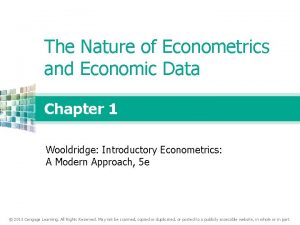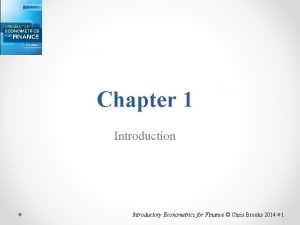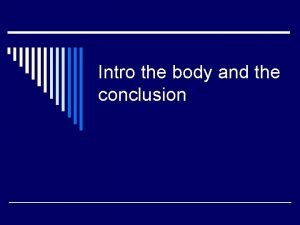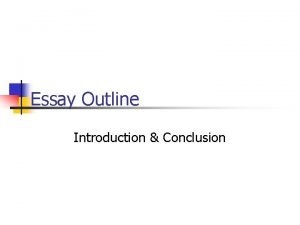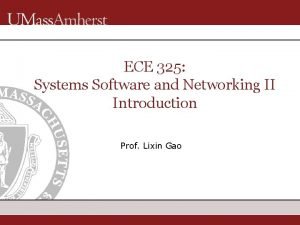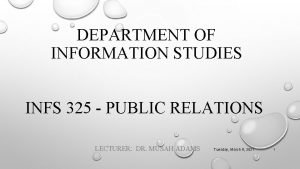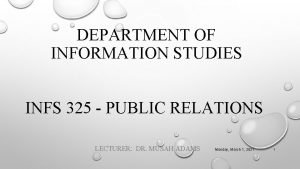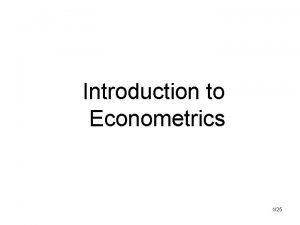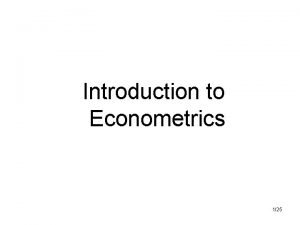Welcome to EE 325 Introductory Econometrics Introduction n











- Slides: 11

Welcome to EE 325 Introductory Econometrics Introduction n. Why study Econometrics? n. What is Econometrics? n. Methodology of Econometrics EE 325 Introductory Econometrics 1

Course Goals n n To provide students an understanding of why econometrics is necessary and a working ability with basic econometric tools such that: Students can apply basic econometric tools to estimation, inference, and forecasting in the context of real world economic problems Students understand how to process information from a sample of economic data Students can read critically the results and conclusions Students have a foundation for further study of advance econometrics. EE 325 Introductory Econometrics 2

Why study Econometrics A gap exists between what you have learned as an economics student and what economists actually do n Most economists engage in economic analysis (empirical: use economic data to estimate economic relationships, test economic hypotheses, and predict economic outcome) n Studying Econometrics fills this gap n EE 325 Introductory Econometrics 3

What is Econometrics? “ Econometric is based upon the development of statistical methods for estimating economic relationship, testing economic theories, and evaluating and implementing government and business policy” (wooldridge p. 1) n Econometrics is concerned with using data to test a theory or to estimate a relationship— empirical economic analysis. n EE 325 Introductory Econometrics 4

What is Econometrics? The study of Econometrics: n Estimation of economic relationship n Testing of hypotheses about economic theory n Forecasting EE 325 Introductory Econometrics 5

What is Econometrics? Econometrics has evolved as a separate discipline from statistics because - Rare in economics (and many other areas without labs!) to have experimental data. Econometrics focuses on the problems inherent collecting and analyzing nonexperimental, or observational, data - Economists have developed new techniques to deal with the complexities of economic data and to test the predictions of economic theories n EE 325 Introductory Econometrics 6

Methodology of Econometrics Steps in Empirical Economic Analysis 1. Formulation of the question of interest, statement of theory or hypothesis 2. Formulating a model (based on economic theory, past experience or intuition, other studies): -specification of the mathematical model of theory -specification of the statistical, or econometric model EE 325 Introductory Econometrics 7

Methodology of Econometrics 3. 4. 5. 6. 7. Obtaining the data Estimation of the parameters of the econometric model Hypothesis testing Forecasting or prediction Policy decision EE 325 Introductory Econometrics 8

Types of Data – Cross Sectional n n n Cross-sectional data: Data collected over sample units in a particular time period Consists of a sample of individuals, households, firms, cities, states, countries, or a variety of other units, taken at a given point in time. for example: income by province in Thailand during 2006. (How many observation do we have? ) Often obtained by random sampling from the underlying population EE 325 Introductory Econometrics 9

Types of Data – Time Series n n Time series data: data collected over discrete intervals of time (observations on variable(s) over time) Time series data has a separate observation for each time period – e. g. annual gross domestic product of Thailand from 1980 -2005 Since not a random sample, different problems to consider Trends and seasonality will be important EE 325 Introductory Econometrics 10

Types of Data – Pooled cross sections & Panel n Can pool random cross sections and treat similar to a normal cross section – known as pooled cross section data. Will just need to account for time differences. n Can follow the same random individual observations over time – known as panel data or longitudinal data. (consists of time series for each cross-sectional member in the data set) EE 325 Introductory Econometrics 11
